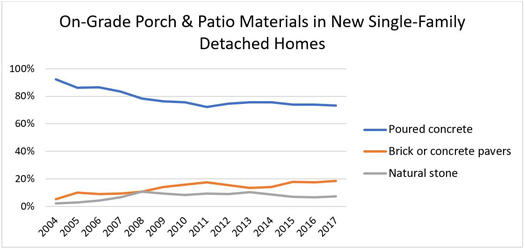August 17, 2018
Who’s on Deck? Outdoor Living Data Reveals Dramatic Swing in Builder Choice of Surface Materials
According to data from Home Innovation’s 2018 Annual Builder Practices Survey, more new homes are getting side & rear porches and decks than in past years, but fewer are getting on-grade patios. The inclusion of front porches and stoops on new homes, however, has fairly stable over the past decade.
Patios, typically on-grade structures found at the side and rear entries of homes, were much more commonplace in the 2000s. Thirteen years ago, they were found on about 60% of all new Single-Family Detached (SFD) homes. Today, they are found on only about a third of new homes. Taking the place of patios, and continuing to grow in popularity on new homes, are outdoor decks and side or rear porches.

Source: Home Innovation's Annual Builder Practices Reports
Why the shift?
Patios have many advantages over these competing (and now outpacing) outdoor living features — they are generally lower in cost, and it’s typically easier to integrate landscaping, fireplaces, and outdoor kitchens into a patio design as compared to decks and porches. There are numerous materials and finishes to choose from for patio construction too — including stone, brick, tiles, concrete paving, and decorative concrete. Decks and covered porches have the added disadvantage of requiring an above-grade sub-structure, hand railing systems, stairways to the yard, and in the case of porches, support columns and a roof. There are the code approvals needed for above-grade structures compared to on-grade surfaces, as well.
So why is the higher-cost alternative gaining in the market? In addition to an improving economy that favors higher-end purchases, there are two other likely factors. First, patios are typically best suited for flat lots, which are becoming more scarce as high-quality buildable lots have fallen into short supply. Decks and porches are sometimes the best alternative for sloped lots. Second, because decks and porches are very often built with a walking surface at about the same level of the adjacent indoor living areas, they give the feeling of continuity between inside and outside living areas.
In addition to the changes going on in the mix of outdoor living features delivered with new homes, builder selections for the walking surface material is also changing. For patios and on-grade porches, builders are adding more decorative options to the traditional poured concrete, which represented 90% of this market a little more than a decade ago, but now only represents 75%.

Source: Home Innovation's Annual Builder Practices Reports
Brick and concrete pavers are trending up as an alternative to poured concrete – brick and concrete pavers represented only about 5% of this market in 2004; they have increased nearly five-fold to about 20% at the present. Natural stone is also now also breaking through – this material was hardly used at all on new home porches and patios in 2004, but now represents nearly 10%.
As for decking materials, the biggest winners in the past decade have been polymers — wood plastic composites, like Trex, and new PVC deck board materials, such as AZEK. The share of these polymer-based decking materials has grown from about 20% to nearly 50% in only 13 years – that’s a meteoric rise in the sphere of home building materials. This phenomenal growth has been due to improvements in manufacturing and the introduction of a new decking material category, solid PVC decking, which garnered about 7% of this market in 2017. Interestingly, lumber decking is still dominant in the repair and replacement market, and plastic composite and PVC have made much smaller inroads.

Source: Home Innovation's Annual Builder Practices Reports
Naturally rot-resistant lumber species, like cedar and redwood, have been fairly stable to declining, no doubt giving up some market share to polymer-based alternatives. Treated lumber, on the other hand, has seen a more marked decline from about 60% to 37% of the new home decking market.
I expect the future will be kind to plastic materials — particularly if technology advances continue; if U.S. lumber prices continue to rise; and if plastic feed stock prices continue to remain moderate. My prediction could change, however, if lumber price begin to decline, or if new, more cost-effective outdoor lumber treatment methods are commercialized, specifically improving the long-term durability of lumber decking.
If this summary makes you want to deck your desk with data, get in touch. We’d love to help you understand the trends your product market is experiencing, or even uncover some new trends.
Back to Top